Unit5 The Power of Nature 说课稿
- 格式:doc
- 大小:40.00 KB
- 文档页数:3
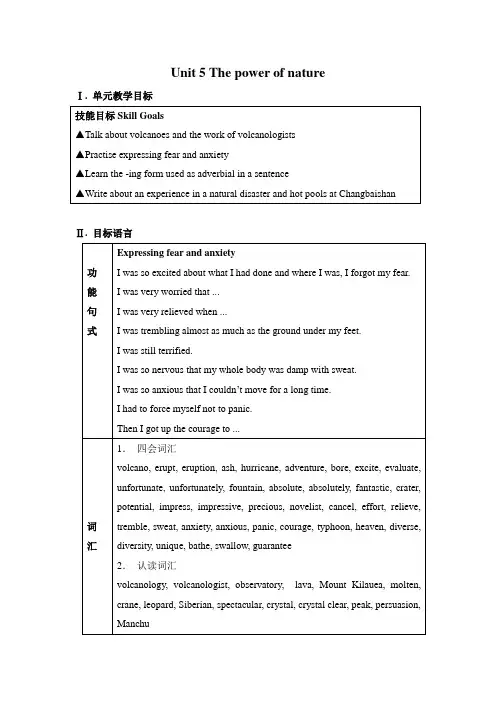
Unit 5 The power of nature Ⅰ. 单元教学目标Ⅱ. 目标语言Ⅲ. 教材分析与教材重组1.教材分析本单元以The power of nature 为话题,旨在通过单元教学使学生了解火山爆发、地震、台风、洪水等自然现象,认识到自然的伟大力量,并会用所学词汇描述在经历自然灾害时的感受,思考人类应对自然灾害的态度和方法,提高自我保护意识。
1.1 Warming Up通过对火山爆发示意图的讨论激活学生了解与本单元话题相关的背景知识,而后通过讨论人类应对自然灾害的措施引发学生对本单元话题的思考,激发学生的求知欲,为随后进行的听、说、读、写打下基础。
1.2 Pre-reading通过回答问题测试自己是否适合作火山学家,让学生了解这一陌生职业,为阅读做好准备。
1.3 Reading部分一位火山学家以第一人称的形式讲述了自己的工作及第一次目睹火山爆发时的情景和心情,描写了人与自然的斗争与和谐相处的乐趣,使学生认识到火山是美丽的,但同时极具破坏力,而火山学家的工作可以减少由火山引发的损失。
1.4 Comprehending设计了两种题型:第一题要求学生在阅读后回答相关问题;第二题检测学生对文章细节的理解。
1.5 Learning about Language 分为词汇和语法两部分。
词汇部分着重从词的意义用法和表达方面对学生学习词汇给予指导;语法部分学习ing 形式在句子中作状语表示时间、原因及结果。
1.6 Using Language以语言实践为目的,包括四个部分的内容。
Listening and speaking 三位火山学家讲述了他们各自最惊险的一次经历。
学生在练习听力的同时学会描述害怕和紧张的词汇。
Speaking 是Listening的延续。
要求学生讲述自己类似的经历,同时在运用中巩固单词。
Reading 介绍了旅游胜地The Lake of Heaven, 培养学生快速获取信息的能力。
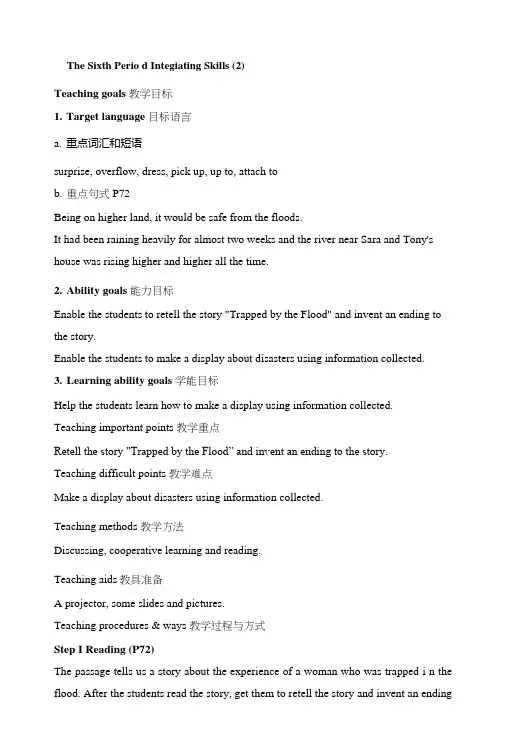
The Sixth Perio d Integiating Skills (2)Teaching goals 教学目标1.Target language 目标语言a.重点词汇和短语surprise, overflow, dress, pick up, up to, attach tob.重点句式P72Being on higher land, it would be safe from the floods.It had been raining heavily for almost two weeks and the river near Sara and Tony's house was rising higher and higher all the time.2.Ability goals 能力目标Enable the students to retell the story "Trapped by the Flood" and invent an ending to the story.Enable the students to make a display about disasters using information collected.3.Learning ability goals 学能目标Help the students learn how to make a display using information collected.Teaching important points 教学重点Retell the story "Trapped by the Flood” and invent an ending to the story.Teaching difficult points 教学难点Make a display about disasters using information collected.Teaching methods 教学方法Discussing, cooperative learning and reading.Teaching aids教具准备A projector, some slides and pictures.Teaching procedures & ways 教学过程与方式Step I Reading (P72)The passage tells us a story about the experience of a woman who was trapped i n the flood. After the students read the story, get them to retell the story and invent an endingto the story.T: Look at the two pictures on .page 73. What is happening?SI: A woman was trying to escape from a flood. She was climbing up to the roof with her baby on her back. She also took her cat and dog along. It/s still raining heavily. The water level had risen to the window. Sitting on the roof, she put on the raincoat and waited for rescue.T: Now let's read the text and find what happened to the woman.After reading.T: Was Sara rescued? The story still needs an ending. Suppose you are Sara and imagine what happened at last. Then retell the story to your partners.A sample version:Trapped by the FloodYou cannot imagine the terrible day. It had been raining for two weeks. The river near our house was rising higher and higher all the time. Tony, my husband, and others from the village had spent the last two days putting sandbags along the side of the river to stop it overflowing. Finally they feared that their hard work had been useless and soon the whole village would flood. He rang me immediately and asked me to go to my mother^ place, which was on higher place and would be safe from the flood・ I was preparing for a nice dinner. The next day was my husbands birthday. I wanted to cook him a nice meal and surprise him with the new mountain bike Fd bought for him I was a little disappointed, but I followed his advice. I dressed baby James in warm clothes and collected the things I would need over the next few days. I put the lead on the dog, Rosie, went to search for the cat, Monty. It took me a long time to look for it. At last, I found him under the covers on my bed. As I was reaching for the car keys, I heard a sound. I looked at the back door and saw the water flowing in underneath. Attaching baby to my back, I ran to the front of the house and out into the front garden with Rosie and Monty. It seemed that the water would soon be much deeper, I ran to the car, climbed first onto the front of the car and then onto the roof. Sitting on the roof, I found the water rushing past the car, was already half way up the doors and still rising. I put on the raincoat to protect my baby from the rain. Luckily, I found my mobile phone inmy pocket. I dialed my mother, but I couldn^t get through. Telephone poles must have been brought down by fallen trees. u What should I do?" Waiting on the roof anxiously, I looked around, hoping to find a boat to save us. Suddenly, I heard someone calling me. " Where are you?” I shouted. u Here. In the tree." I looked towards the trees. Mr White was in the tree. The water was rushing under him.“Catch the tree tightly.” I shouted. u Don't worry! They will come to save us.” We encouraged each othe匚Half an hour past, the rain stopped. The baby cried hungrily. Rosie and Monty lay silently. "Why don^t they come to save us? What happened? They will find us soon/' 1 had to force myself not to panic. Just then I heard my husband calling me. “We are here, on the roof.v I waved happily. We were saved at las 匸I was relieved when we finally reached a safe place.Step II Listening (P73Get the students to listen to the material and make a timeline of Sara's story.T: We are going to listen to Sara telling her mother about her experience. Is the ending the same as the ending that you invented? Listen and make notes about the main events in the story. Then make a timeline according to your notes.The students listen and make notes. After they complete their timeline, check their answers in class.Step III ProjectT: Share your information, pictures and diagramswith others and get into a group with those who are interested in the same kind of disaste匚Then decide how to make your display and who is going to do what.After the students finish, ask two groups to present their work in class.A sample version:Mud-rock FlowFirst, I will show what causes mud-rock flow. Take Yuyang, a county in Yunnan, for example.The old Yuyang County is located in an ancient landslide 223.7 km from the dam site, which has been divided into eastern and western parts. The eastern town slide is less than 190 meters in height and the volume is 400x104x3. The western town slide is lessthan 350 meters in height and has a volume of 2500x104x3. The slide mass consists of silty clay with calcareous nodules, silty clay intermingled with rock detritus and disintegrated rocks, with depth of 44m. The silty clay intermingled with rock detritus and the disintegrated rocks formed the sliding surface with a depth of 0.63-6.6m> The front of the slide is near the river.Many deformations occurred in different places since 1982 and surface drainage and consolidation measures were applied by local government. On the morning of January 17 in 2001, the collapse and landslide occurred, with a total volume of over 5x104x3. Rock masses with soil sided along the slope, cumulating over the slope 500m high. A small quantity of large rock masses broke its way into the town and caused harm to the residential areas. A hazardous rock mass of 2-3 X 104X3 remained on the top of the slope. The collapse masses and hazardous rock mass are in an unstable state. On April 19, part of the collapse masses fell off. On July 12 and 1& triggered by the rainfall, the collapse masses slide twice and intruded the town area in the form of mud-rock flow, endangering the residents and the buildings.Sometimes, the mud-rock flow was caused by continuous, heavy rainfall from Typhoon. The following is an actual event that happened in China.At least 11 people have been killed and 34 are missing in a rare mud-rock flow brought by floods in two counties of southwest China^s Yunnan Province. Six people were seriously injured and 360 more people were stranded in the flood and mud-rock flow, with 2,100 houses toppled and over 1,000 heads of cattle killed.The government and peopl e help them immediately.The Yunnan Provincial Civil Affairs Department has quickly transported quilts and clothes to the two counties, and over 3,900 people have been removed from the disaster-hit areas.The Yueqing municipal government has al located 30 million yuan (US$3.6 million) of relief fund and aroused more than 300 people to search for the missing villagers and restore infrastructure.Each victim^ family received an 20,000 yuan (US$2,400) allowance from the government, said Mayor Huang Zhengqiang.The government also allocated rice, pork, salt, vegetables and mineral water to the villagers, as the catastrophe cut off water and food supplies.The government has taken some measures to lessen the damage.The municipal government plans to relocate several of the villages to safer locations before February 2005・ Meanwhile, the government has solicited donations from local enterprises and asked the villagers to help themselves and resume production at an earlier date.Step IV HomeworkT: Do SUMMING UP and CHECKING YOURSELF to check how well you have mastered this unit. So much for this unit. See you next time.附件FLOODS AND DAMSLife Givers, Life TakersThey bring both death and the promise of renewed life, often on the same rushing tide. Floods can cause untold misery. More than 3,000 people were killed and 14 million were homeless in China during the summer of 1998. The cause: the heaviest flooding of China's Yangtze and other rivers since 1954. In 1931 almost four million died along China^s Huanghe, or Yellow River, when it surged over its banks. Heavy summer rains in the U.S. Midwest swelled the Mississippi, Missouri, and several other rivers in 1993, destroying entire towns and covering millions of acres of farmland.But when rivers overflow their banks due to melting snow or torrential rains, floods enrich surrounding land, leaving behind organic material and minerals in the sand, silt, and debris. Ancient Egyptians planned their planting and their lives around the summer flooding of the Nile, which leaves a thin, even coating of black mud along either side when it recedes, leaving the soil so enriched that fertilizer is unnecessary. Flash floods, which rise and fall rapidly with little or no warning, and tsunamis-seismic waves caused by undersea earthquakes and volcanoes 一also drown people and livestock and destroy their habitations, as does flooding due to rains associated with hurricanes.EARTHQUAKESSunday SuipriseMany were caught inside churches that fair Sunday morning. What began as a gentle trembling of the ground quickly grew strong enough to shake buildings. One witness likened the sound coming from the Earth to the rumble of faraway thunder.It was just a foreshock. In the next moment the Reverend Charles Davy was "instantly stunned with a most hoirid crash, as if every edifice in the city had tumbled down at once/' Davy said another survivor recalled seeing "the whole city waving backwards and forwards, like the sea when the wind first begins to rise. ” In all there were three major earthquakes, several tsunamis, and a conflagration that consumed most of the Portuguese city of Lisbon on November 1, 1755-AII Saints5Day. Some estimates put the death toll at over 60,000.Over the millennia earthquakes have killed countless people and tossed their structures about like toys. About 35 earthquakes are observed around the globe every day, and about 18 major ones per yearThey can happen anywhere. A series of quakes near the town of New Madrid, Missouri, during the winter of 1811・ 1812 was felt as far north as Canada, as far south as the Gulf of Mexico, and rattled chinaware in Washington, D.C. Because the U.S. Midwest was so sparsely populated, the death toll was light. Today New Madrid lies within 150 miles (240 kilometers) of two major metropolises: St. Louis, Missouri, and Memphis, Tennessee; and 325 miles (520 kilometers) from Kansas City, Missouri.When a Midwest earthquake happens again, as experts say it surely will, the toll in human life and property destruction is expected to be ghastly.。
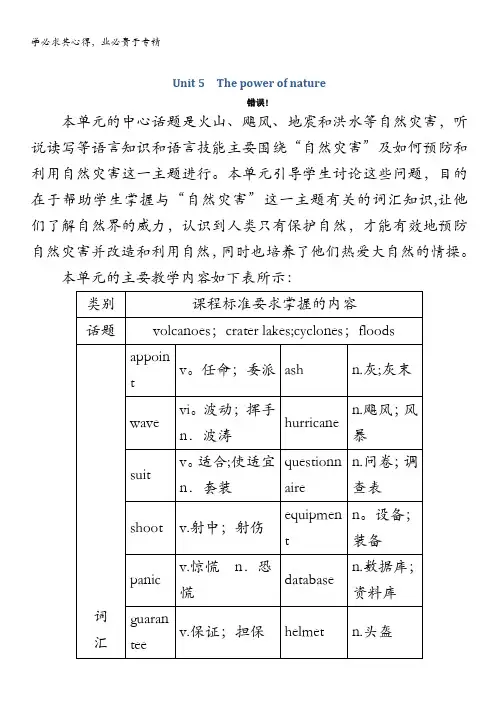
Unit 5The power of nature错误!本单元的中心话题是火山、飓风、地震和洪水等自然灾害,听说读写等语言知识和语言技能主要围绕“自然灾害”及如何预防和利用自然灾害这一主题进行。
本单元引导学生讨论这些问题,目的在于帮助学生掌握与“自然灾害”这一主题有关的词汇知识,让他们了解自然界的威力,认识到人类只有保护自然,才能有效地预防自然灾害并改造和利用自然,同时也培养了他们热爱大自然的情操。
本单元的主要教学内容如下表所示:Period 1 Warming Up,Pre-reading,Readingand Comprehending错误!教学内容分析This is the first teaching period of this unit。
The central part of this period is the reading passage with the name of An Exciting Job showing the students the power of nature。
Warming Up gives two topics for students to discuss,letting students get some more knowledge about the power of nature.Pre-reading provides some questions and a questionnaire to help students focus on the topic of the reading passage and lead the students to think about any personal experiences of working outside,such as things about climbing into a live volcano,doing dangerous work,travelling,taking risks,adventure,studying rocks and so on。
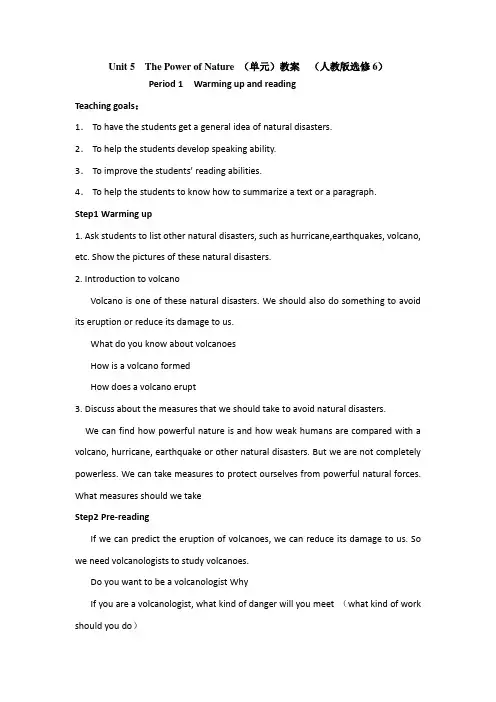
Unit 5 The Power of Nature (单元)教案(人教版选修6)Period 1 Warming up and readingTeaching goals:1.To have the students get a general idea of natural disasters.2.To help the students develop speaking ability.3.To improve the students’ reading abilities.4.To help the students to know how to summarize a text or a paragraph.Step1 Warming up1. Ask students to list other natural disasters, such as hurricane,earthquakes, volcano, etc. Show the pictures of these natural disasters.2. Introduction to volcanoVolcano is one of these natural disasters. We should also do something to avoid its eruption or reduce its damage to us.What do you know about volcanoesHow is a volcano formedHow does a volcano erupt3. Discuss about the measures that we should take to avoid natural disasters.We can find how powerful nature is and how weak humans are compared with a volcano, hurricane, earthquake or other natural disasters. But we are not completely powerless. We can take measures to protect ourselves from powerful natural forces. What measures should we takeStep2 Pre-readingIf we can predict the eruption of volcanoes, we can reduce its damage to us. So we need volcanologists to study volcanoes.Do you want to be a volcanologist WhyIf you are a volcanologist, what kind of danger will you meet (what kind of work should you do)Let’s learn something about volcanologists in the text.Step 3 Skimming1. Read through the passage quickly and find out the answers to the questions. What kind of things should a volcanologist doWhat is the volcanologist wearing when getting close to the crater2. Divide the passage into several parts and find out the main idea of each part. Step 4 ScanningScan the passage .Read the passage carefully and answer the following questions.1.Why is a volcanologist’s job important2.Where is Mount Kilauea3.Why is the lava that flows on Mount Kilauea more dangerous than the actualeruption4.What caused the writer’s bedroom to become as bright as day even though it wasnight5.Why did the scientists have to get close to the volcano after it began erupting6.Why was it difficult for the writer to walk towards the edge of the crater7.What does the writer find impressive about volcanoes even after studying themfor 20 yearsStep 5 DiscussionT1 Do you think it is an occupation you would enjoy Discuss your reasons with your classmates.T2 InterviewMake up an interview. Four students as a group. One student acts as the writer of the passage. The other three students act as the journalists from three different TV stations.Step 6 Homework:Spend some time researching one disaster. You can use books, magazines, newspapersor the Internet. Collect pictures and diagram and look for information about:• what causes this kind of disaster• actual events that h appened in the past in china and/or the rest of the world • how people helped the victims• what is being done to prevent the disaster happening again or to lessen the damagePeriod 2 Learning about LanguageTeaching goals:1.To help the students to learn how to use words and expressions.2.To review the V-ing form and learn the perfect V-ing form.Step 1 Discover useful words and expressions1.Show the video of an episode of Vesuvius eruption and ask students to fill in thetext with proper words.The eruption of Mount Vesuvius in 79AD took people in Pompeii by surprise. It was so quick and so severe that the town was soon covered in ________ and ________. Many houses in the town were ________. It was an ________ disaster for many people who could not get away in time. A writer named Pliny, who was there during the _______, described how lava was thrown into the air like a ________. ________ many of the townspeople, ________ at the ________ sight of Vesuvius eruption, stayed too long and failed to escape in time.2.Find suitable words or expressions from the texts in the unit to fill in the blankson page35.Step2 Grammar1.Show a flash to review the differences between V-ing and the past participle.a.现在分词表示主动,过去分词表示被动。
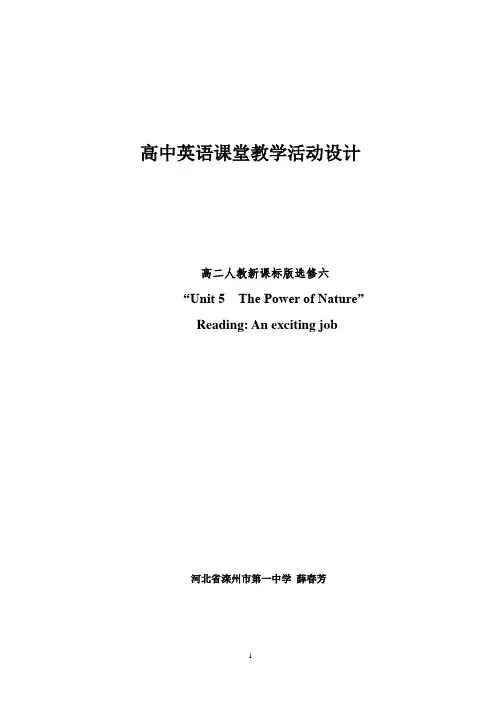
高中英语课堂教学活动设计高二人教新课标版选修六“Unit 5 The Power of Nature”Reading: An exciting job河北省滦州市第一中学薛春芳一、Text Analysis教学内容分析本单元以The power of nature为中心话题,听说读写等语言知识和语言技能主要围绕“自然灾害”及如何预防和利用自然灾害这一主题设计的。
本单元引导学生讨论大自然的危害等问题,目的在于让他们了解大自然的威力,认识到大自然的伟大力量,认识到只有保护大自然,才能有效地预防自然灾害并改造和利用大自然。
并会用所学词汇描述在经历自然灾害时的感受,思考人类应对自然灾害的态度和方法,提高自我保护意识。
Reading部分是一位火山学家的自述。
作者首先介绍了他的工作性质,说明他热爱该项工作的主要原因是能帮助人们免遭火山袭击。
作者的主要工作是收集基拉韦厄火山的资料,并和其他科学家一起分析和预测火山岩浆的流速和方向。
火山爆发不会造成很大的损失,因为山顶附近没有居民。
但是,从山上流下的熔岩会烧毁和埋没周围的城镇。
然而,观看火山爆发是非常令人兴奋的,红色的熔岩喷向高空,高达数百米,甚是壮观。
有一次火山爆发后,作者和另外二位科学家一道来到火山口。
他们身穿白色的防护服,艰难地走近火山口,观察沸腾的火山口中央,并采集了部分岩浆以作研究。
最后,作者表述了他对自己工作的热情。
在从事这项工作20年后,火山对他的吸引力依然不减。
这部分教学内容在整个单元都起着重要的桥梁和纽带作用,不仅是对“热身”部分有效的延伸和扩展,让学生对火山学家有了更深层次的了解,而且对于下节课的写作是个很好的铺垫。
二、教学对象分析高二学生已经对自己的未来取向有了一定的定位,在此基础上阅读一篇火山学家工作的文章,尤其是利用各种现代化教学手段帮助他们进行理解感悟,可以对他们以后的学习或工作有所帮助。
但由于文章生词量的原因,阅读时会影响一定的速度并且在深层理解上会有一定的困难。
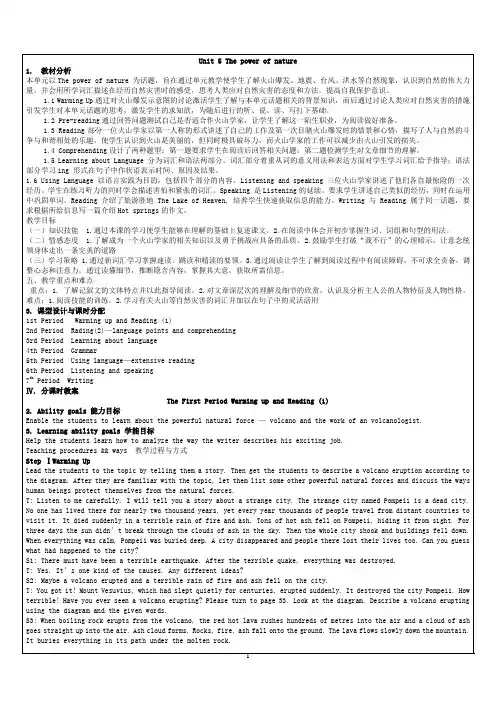
Unit 5 The power of nature1.教材分析本单元以The power of nature 为话题,旨在通过单元教学使学生了解火山爆发、地震、台风、洪水等自然现象,认识到自然的伟大力量,并会用所学词汇描述在经历自然灾害时的感受,思考人类应对自然灾害的态度和方法,提高自我保护意识。
1.1 Warming Up通过对火山爆发示意图的讨论激活学生了解与本单元话题相关的背景知识,而后通过讨论人类应对自然灾害的措施引发学生对本单元话题的思考,激发学生的求知欲,为随后进行的听、说、读、写打下基础。
1.2 Pre-reading通过回答问题测试自己是否适合作火山学家,让学生了解这一陌生职业,为阅读做好准备。
1.3 Reading部分一位火山学家以第一人称的形式讲述了自己的工作及第一次目睹火山爆发时的情景和心情,描写了人与自然的斗争与和谐相处的乐趣,使学生认识到火山是美丽的,但同时极具破坏力,而火山学家的工作可以减少由火山引发的损失。
1.4 Comprehending设计了两种题型:第一题要求学生在阅读后回答相关问题;第二题检测学生对文章细节的理解。
1.5 Learning about Language 分为词汇和语法两部分。
词汇部分着重从词的意义用法和表达方面对学生学习词汇给予指导;语法部分学习ing 形式在句子中作状语表示时间、原因及结果。
1.6 Using Language以语言实践为目的,包括四个部分的内容。
Listening and speaking 三位火山学家讲述了他们各自最惊险的一次经历。
学生在练习听力的同时学会描述害怕和紧张的词汇。
Speaking 是Listening的延续。
要求学生讲述自己类似的经历,同时在运用中巩固单词。
Reading 介绍了旅游胜地 The Lake of Heaven, 培养学生快速获取信息的能力。
Writing 与Reading 属于同一话题,要求根据所给信息写一篇介绍Hot springs的作文。
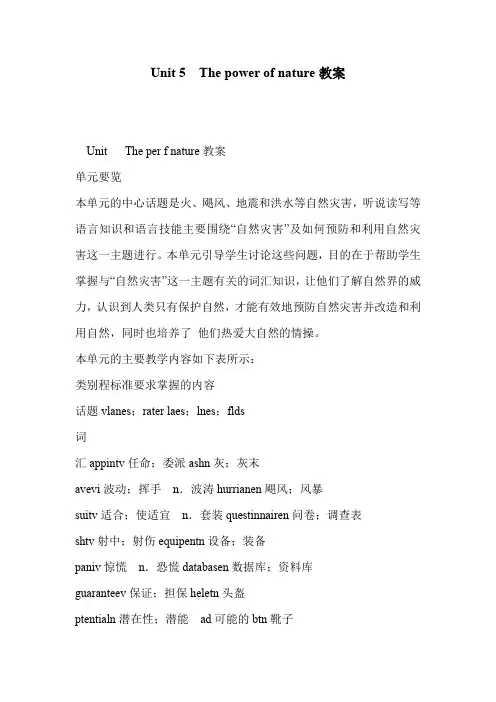
Unit 5The power of nature教案Unit The per f nature教案单元要览本单元的中心话题是火、飓风、地震和洪水等自然灾害,听说读写等语言知识和语言技能主要围绕“自然灾害”及如何预防和利用自然灾害这一主题进行。
本单元引导学生讨论这些问题,目的在于帮助学生掌握与“自然灾害”这一主题有关的词汇知识,让他们了解自然界的威力,认识到人类只有保护自然,才能有效地预防自然灾害并改造和利用自然,同时也培养了他们热爱大自然的情操。
本单元的主要教学内容如下表所示:类别程标准要求掌握的内容话题vlanes;rater laes;lnes;flds词汇appintv任命;委派ashn灰;灰末avevi波动;挥手n.波涛hurrianen飓风;风暴suitv适合;使适宜n.套装questinnairen问卷;调查表shtv射中;射伤equipentn设备;装备paniv惊慌n.恐慌databasen数据库;资料库guaranteev保证;担保heletn头盔ptentialn潜在性;潜能ad可能的btn靴子anxietn担心;焦虑;渴望andidaten候选人;候补者abslutead绝对的;完全的bungaln平房;小屋atualad实在的;实际的tphnn台风anxiusad焦虑的;不安的thunderstrn雷暴alngsideadv在旁边;沿着边prep在……旁边;沿着……的边nvelistn 小说家absluteladv绝对地;完全地fgn雾eruptvi(指火)爆发;突然发生duentn;证evaluatev评估;评价;估计rainbn彩虹funtainv 泉水般地喷出或涌出n.喷泉;泉balnn阳台treblevi摇晃;摇动;颤抖shtn射击;枪炮声seatvi出汗n.汗appreiatinn欣赏;感激;感谢bathevi洗澡;游泳preiusad贵重的;珍贵的diagran图解;图表;示意图unfrtablead不舒服的;不舒适的vlann火unnsiusad失去知觉的;未察觉的eruptinn火爆发;(战争等)爆发diversead 多种多样的;不同的ae ne’s a 前往burn t the grund全部焚毁glane thrugh 匆匆看一遍attaht把……附在……上var frt由……到……不等pareith把……和……做比较a live vlan 一座活火be abut t d 即将;马上;正要做part f 部分run ut f 跑出去;用光;耗尽ut f the a不挡道;不碍事;躲开l dn int向下看be vered ith被……所覆盖,遮掩taeb surprise使……吃惊a great diversit f 多种多样的be he t 是……的栖息地;原产地in the distane 在远处;在远方pi up 拾起;捡起n earth 在地球上;究竟;到底;根本prtet sb/sthagainst/fr sth保护……不受……的伤害句型1Having_lleted_and_evaluated_the_infratin,I help ther sientists t predit here lava fr the vlan ill fl next and h fast(the -ing fr)2I as_abut_t g ba t sleep hen suddenl bedr beae as bright as da(sbbe abut t d sthhen)3The ther t libed dn int the rater t llet se lava fr later stud,but this_being__first_experiene,I staed at the tp and athed the(the -ing fr) 4Having_studied_vlanes_n_fr_an_ears,I a still aazed at their beaut as ell as their ptential t ause great daage(the -ing fr)b is lleting_infratin_fr_a_database_abut_unt_ilauea(the -ing fr)6I as appinted as a vlanlgist ring_fr_the_Haaiian_Vlan_bservatr(HV)_tent_ears_ag(the -ing fr)功能情感:喜悦、恐惧、焦虑、惊奇(Etins:,fear,anxiet,surprise)I beae s exited that I’ ling frard tPerfet! u did a gd bI’ frightened I as treblingI as s anxius I felt ver nervush,gdness h,n!I had never felt s happ as Desn’t that l lvel?I an’t ait I as never s frightenedhat’s happening? hat’s happened?hat’s that nise? here’s the?语法复习-ing形式(Revise the -ing fr)I as appinted as a vlanlgist ring fr the Haaiian Vlan bservatr(HV) tent ears agb is lleting_infratin_fr_a_database_abut_unt_ilaueaHaving_red_hard_all_da,I ent t bed earlHaving_experiened_quite_a_fe_earthquaes_in_Haaii_alread,I didn’t tae uh ntie教学重点1Get students t n abut disasters that are aused b natural fres2.Have students learn se useful ne rds and expressins abut natural disasters and let the learn effetive as t aster the3.Enable students t express their etins suh as ,fear,anxiet and surprise 4.Let students get a better understanding f the graar ite:the -ing fr .Develp students’ listening,speaing,reading and riting abilit教学难点1Enable students t aster the usages f the -ing fr2.Let students learn t rite a letter expressing etins3.Develp students’ integrative sills时安排Perids needed:6Perid 1aring Up,Pre-reading,Reading and prehendingPerid 2Language StudPerid 3Graar—the -ing FrPerid 4Listening and SpeaingPerid Reading and ritingPerid 6Suing Up,Learning Tip and AssessentPerid 1aring Up,Pre-reading,Readingand prehending整体设计教学内容分析This is the first teahing perid f this unitThe entral part f this perid is the reading passage ith the nae f An Exiting b shing the stude nts the per f naturearing Up gives t tpis fr students t disuss,letting students get se re nledgeabut the per f naturePre-reading prvides se questins and a questinnaire t help students fus n the tpi f the reading passage and lead the students t thin abut an persnal experienes f ring utside,suh as things abut libing int a live vlan,ding dangerus r,travelling,taing riss,adventure,studing rs and s n Reading is a first-persn aunt f a vlanlgist’s experienesHe lves his b ver uh beause he an help prtet rdinar peple fr ne f the st perful fres n earthHis b is lleting infratin fr a database abut unt ilauea and helping ther sientists t predit here lava fr the vlan ill fl next and h fastne,he athed an eruptin and then lleted se lava fr later studAfter an ears,he is still enthusiasti abut his bReading ntains a piture that is an abslutel fantasti sightAfter a glane at the title f the text and the headlines ithin it e n that it is an aunt,in hih there are an etin expressinsThen e an understand the tpi f the text and h the infratin is rganizedprehending nsists f three ritten r ral exerises fr the students t d s as t help the students t get a better understanding f the text,that is t sa,t help the teaher t he h uh the students have understd the text三维目标设计nledge and sills1.T n the eanings f the flling ne rds and phrases:diagra(示意图),vlan(火),erupt(爆发),eruptin(火爆发),ash(灰末),hurriane(飓风),questinnaire(调查表),alngside(在旁边;在……旁边),equipent(装备),appint(委派),database(数据库),evaluate(评估),ave(波浪),funtain(泉水般地喷出或涌出;喷泉;泉),abslute(绝对的),abslutel(绝对地),suit(一套外衣),helet(头盔),bt(靴子),ptential(潜在性;潜在的),atual(实在的),burn t the grund(全部焚毁),ae ne’s a(前往).2.T learn abut se disasters that are aused b natural fres,h peple feel in dangerus situatins and the as in hih huans prtet theselves fr natural disasters3.T learn h the infratin is rganized4.T develp the students’ reading abilit b siing and sanning the passage .T develp the students’ speaing abilit b taling abut natural fresPress and ethds1.hile ding aring Up the teaher an lead in the tpi f this unit b shing students se pitures f natural disasters and intrduing se tehnial vabular nerning vlanes t revie and deve lp students’ understanding f hat a vlan isT as students t nsider ther natural disasters and the as huans deal ith the 2.During Pre-reading the teaher an g arund the lassr and dis uss the questins ith several studentsThis disussin shuld be student-entered and aruse students’ interest in ring utsideThe teaher shuld als as the students se questins and tr t let the have a general nledge f vlanes3.hile ding Reading and prehending,the teaher a first as the students t read the text quil t get the general idea f eah paragraphAfter reading the passage arefull,students are enuraged t anser se questins and disuss thetext struture4.T nslidate the ntents f the reading passage,the students shuld be required t retell the vlanlgist’s experienes in their n rds at the end f the lassEtin,attitude and value1.T stiulate students’ lve t nature2.T develp students’ sense f perative learning教学重、难点1.T enable the students t learn abut the per f nature and t develp their reading abilit2.T enable the students t tal abut natural fres教学过程aring up1.aring up b ling and talingSh the flling pitures t the students and let the n abut the per f nature and tal abut theSaple expressins:hat happened in the pitures abve?D u n an ther natural disasters?Please r ith ur partners and ae a list f natural disasters(suh as earthquae,snstr,fld,drught).Have u ever seen a vlan?(Se ne rds:lava erupt/eruptin rater ative/drant/extint vlanes) 2.aring up b reading the passage belSe nledge abut vlanesThere are thusands f vlanes all ver the rldhat aes vlanes?hat happens? The inside f the earth is ver htBeause it is ver,ver ht,the r has elted lie ieIt has bee liquid,lie aterIt is alas biling,lie ater in a ettleIf u have seen a ettle biling,u n that the stea and biling ater tr t get utThe ver ht elted r inside t he earth als tries t get utUsuall it annt beause the utside f the earth is t thi and strngBut in se plaes the utside f the earth is thin and eaSeties a ra(a sall pening)appearsThe ht elted r,hih e all “lava”,pushes up thrugh the ra and bursts thrughStea and gas sht up int the air and the ht elted lava purs utBig piees f r a be thrn high int the airAfter a hile the vlan bees quiet againThe elted lava bees hardLater the sae thing happens again and againEah tie re ht lava purs ut n tp f the ld lava and then bees hardIn this a a ind f untain is built up,ith a hle dn the iddlePerhaps the vlan ill then be quiet and n re lava ill burst utPerhaps it ill start again hundreds f ears laterVesuvius is the nae f a ver faus vlan in ItalIt first ae t life an,an ears agIt as quiet fr hundreds f earsThen in the ear 79 it suddenl burstA great lud f se sht up int the s ith great burning rs,hih fell all arundHt lava pured dn its sidesAbut 3000 peple ere illedPre-reading1an u iagine libing int a live vlan in rder t easure the teperature f the biling r inside?N,read the flling passage pleaseh des Tazieff ris his life lie this?Harun Tazieff,the plish sientist,has spent his lifetie studing ative vlanes and deep aves in all parts f the rldIn 1948,he ent t Lae ivu in the ng t bserve a ne vlan hih he later naed iturTazieff as able t set up his ap ver lsed t the vlanes hile it as erupting vilentlThugh he anaged t tae a nuber f b rilliant phtgraphs,he uld nt sta near the vlanes fr ver lngHe ntied that a river f liquid r as ing tards hiIt threatened t surrund hi pletelBut Tazieff anaged t esape ust in tie,he aited until t he vlanes beae quiet and he as able t return t das laterThis tie,he anaged t lib int the uth f itur s that he uld tae phtgraphs and easure teperaturesTazieff has ften rised his life in this aHe has been able t tell us re abut at ive vlanes than an an alive 2.Enurage students t tal re abut vReading and prehending1.Fast-reading:As students t si the passage s as t get the e rds and general idea f eah paragraph and anser the questin:hat’s the ain idea f the text?2.Read the passage arefull and anser the flling questins(1)h is a vlanlgist’s b iprtant?(2)h is the lava that fls n unt ilauea re dangerus than the atual eruptin?(3)h as it diffiult fr the riter t al tards the edge f the rater?(4)hat des the riter find ipressive abut vlanes even after studing the fr an ears?()hat did the authr thin it as hen an eruptin urred?(6)h did the sientists l lie spaeen?Suggested ansers:1.This passage is a first-persn aunt f a vlanlgist’s experienesThe vlanlgist desribed his exiting b and rte dn his first sight f an eruptin 2.(1)Vlanlgists stud vlanes s that the an arn peple hen the vlan is ging t erupt and s save an lives(2)The lava fls dn the untain and an ver up r burn villages in its pathThe rs that erupt fr the vlan usuall dn’t daage anthing beause n ne lives near the rater(3)The authr as earing speial prtetive lthing that ade it diffiult t al(4)The authr finds their be aut and their ptential t ause great daage ver ipressive()He thught it as an earthquae(6)Beause the re hite prtetive suits that vered their hle bd3.As students t san fr detailed infratin and disuss the flling questin ith their partners and be prepared t reprt t the lassQuestin:Having learned a little re abut the r f a v lanlgist,d u thin it is an upatin u uld en?Give u reasnsSuggested ansers:N,I prbabl uldn’t en this b beause I uldn’t have t live in ther untries and I dn’t lie being in dangerus situatins,eitherAbve all,I’ nt ver gd at sieneRes,I’d lve t d a b lie this beause I uld en ring utside and I thin I uld en the adventureIt uld be exiting t eet peple fr different untries and I uld feel gd abut helping peple avid dangerLanguage studDealing ith an language prble if an(rds r sentenes students ight nt understand)t help the students t have a better understanding f the text Listening,reading alud and underliningAs students t read the passage alud t the tape and let the pa attentin t the prnuniatin f eah rd and the pauses ithin eah senteneTell the t pi ut all the useful expressins r llatins fr the passage hile reading and p the t the nteb after lass as herllatins:ae ne’s a,a live vlan,be abut t d,l dn int,ut f the a,be vered ith,burn t the grund,attaht,pareith,run ut fStruture analzingAfter reading,as students t disuss the text struturees fr referene:This passage is a first-persn aunt f a vlanlgist’s experienesThe vlanlgist desribed his exiting b and rte dn his first sight f an eruptinThe first paragraph intrdues the tpi and the thee f the textThe rest f the text presents the inf ratin in hrnlgial rderA feature f an aunt f a vlanlgist’s experienes is the abundane f tie expressinsThe last sentene f the reprtfuntins as a nlusinIn additin,eah setin begins ith a tpi senteneRetellingAs students t tal abut the vlanlgist’s ex perienes in their n rdsGive the se e rds and expressinsThen let the tr t retell the passageHer1.Learn the useful ne rds and expressins in this part b heart2.Tr t find re pitures shing natural fres and tal abut theRefletin after teahing___________________________________________________________ ________________________________________________________________________ __________Reading:An Exiting bⅠ:Lead-inⅡ:Fast reading:Read the passage An Exiting b as quil as u an and tr t get the ain idea f the passagehat is the ain idea f the passage?A.An eruptin urred in HaaiiB.A vlanlgist’s b is exiting.A vlanlgist’s exiting b and his first sight f an eruptinD.A sight f an eruptin is hrribleⅢ:Detailed reading1.Read the first and the send paragraphs and finish the flling tass①h is a vlanlgist’s b iprtant?___________________________________________________________ _____________②The riter desn’t ind the asinal danger f his b beause______A.he travels t unusual plaes and eets interesting peple fr all ver the rld B.he lies the different as f ring.he thins his b the st iprtantD.he is exited abut danger and feels alive③As a result f the vlanlgist’s b,______A.ther sientists predit the prgress f lava fr the vlanB.an peple have been arned t leave their hes.the eruptin auses less daageD.the eruptin a be prevented fr breaing ut2.Read the third and the furth paragraphs and finish the flling tass①hat ade the riter realize that an eruptin urred?②hat des the riter ean b using “lu” in the sentene “I as lu enugh t have a uh lser l at it”?A.He felt uh safer n the tp hile the ther t sientists libed int the rater B.It as his first sight f an eruptin.It as the first tie fr hi t ath the raterD.Bth B and3.Read the last paragraph and prepare 1-2 questins t as ur partners abut itⅣ:Searhing reading1.Analze the senteneHaving lleted and evaluated the infratin,I helped ther sientists t predit here the lava fr the vlan ill fl next and h fastHaving lleted and evaluated the infratin是______,在句子中作______;predit后是由here和h引导的两个______。
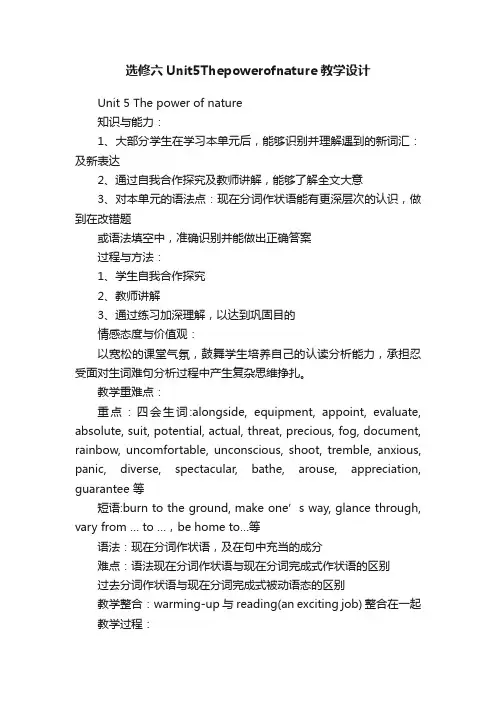
选修六Unit5Thepowerofnature教学设计Unit 5 The power of nature知识与能力:1、大部分学生在学习本单元后,能够识别并理解遇到的新词汇:及新表达2、通过自我合作探究及教师讲解,能够了解全文大意3、对本单元的语法点:现在分词作状语能有更深层次的认识,做到在改错题或语法填空中,准确识别并能做出正确答案过程与方法:1、学生自我合作探究2、教师讲解3、通过练习加深理解,以达到巩固目的情感态度与价值观:以宽松的课堂气氛,鼓舞学生培养自己的认读分析能力,承担忍受面对生词难句分析过程中产生复杂思维挣扎。
教学重难点:重点:四会生词:alongside, equipment, appoint, evaluate, absolute, suit, potential, actual, threat, precious, fog, document, rainbow, uncomfortable, unconscious, shoot, tremble, anxious, panic, diverse, spectacular, bathe, arouse, appreciation, guarantee 等短语:burn to the ground, make one’s way, glance through, vary from … to …,be home to…等语法:现在分词作状语,及在句中充当的成分难点:语法现在分词作状语与现在分词完成式作状语的区别过去分词作状语与现在分词完成式被动语态的区别教学整合:warming-up 与reading(an exciting job) 整合在一起教学过程:The first period:学生自主合作探究,通过阅读,把握全文大意(第一课时)学生活动:学生自主合作探究,通过查看词汇表,查字典,查书后注释,靠自我或小组内成员合作,尽最大力量把握文章大意。
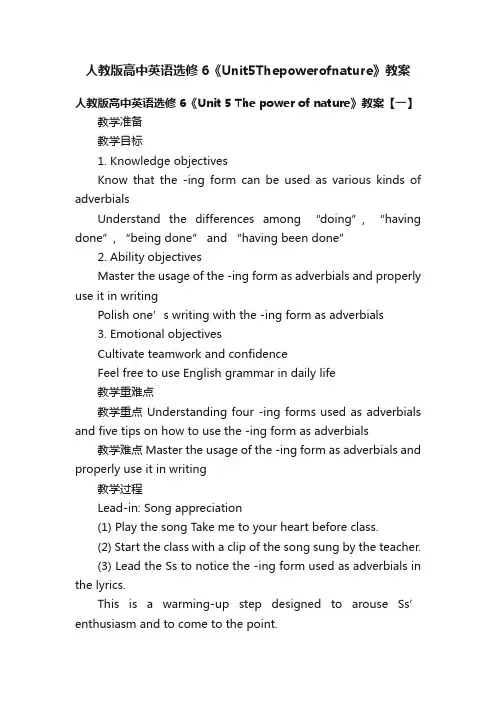
人教版高中英语选修6《Unit5Thepowerofnature》教案人教版高中英语选修6《Unit 5 The power of nature》教案【一】教学准备教学目标1. Knowledge objectivesKnow that the -ing form can be used as various kinds of adverbialsUnderstand the differences among “doing”, “having done”, “being done” and “having been done”2. Ability objectivesMaster the usage of the -ing form as adverbials and properly use it in writingPolish one’s writing with the -ing form as adverbials3. Emotional objectivesCultivate teamwork and confidenceFeel free to use English grammar in daily life教学重难点教学重点 Understanding four -ing forms used as adverbials and five tips on how to use the -ing form as adverbials 教学难点 Master the usage of the -ing form as adverbials and properly use it in writing教学过程Lead-in: Song appreciation(1) Play the song T ake me to your heart before class.(2) Start the class with a clip of the song sung by the teacher.(3) Lead the Ss to notice the -ing form used as adverbials in the lyrics.This is a warming-up step designed to arouse Ss’ enthusiasm and to come to the point.Step 1: We ChooseTask 1: Observe the -ing form in each sentence and decide what it refers to.(reason, result, concession, time, manner, condition)1. Being very rich, he spends as much money as he likes. (reason)2. Working hard, you’ll surely succeed. (condition)3. They sat there, waiting for the beginning of the sports meeting. (manner)4. Walking on the street, he came across a long-lost friend. (time)5. The polar bear was not careful enough, falling on the icy ground. (result)6. Not understanding what you are talking about, I still admire you. (concession)It is intended to remind Ss that the -ing form can be used as various kinds of adverbials. Ask several Ss to answer and, if necessary, interpret the sentences for them with adverbial clauses.Task 2: Check the words in red and decide their relation with the subject and the predicate. (A. active B. passive C. meanwhile D. before-after)Laughing and jumping, he left school.Having finished his homework, he left school.Being talked about at that time, he left school.Having been punished, he left school.First, let Ss choose the correct relation between the -ing form and the subject and that between the -ing form and the predicate in each sentence. Then lead Ss to sum up the differences among “doing”, “having done”, “being done” and “having beendone”.Task 3: Read the sentences aloud and recall the tips.When the reading is finished, ask Ss how to use the -ing form as adverbials.It is intended as a transition from “what” to “how” and the second step is naturally introduced.Step 2: We ChangeTask 1: (Group work) Identify the mistakes in the following sentences and change the sentences into correct ones. Discuss your reason.1. I had a wonderful childhood, travel around the world.2. When crossed the road, you should be careful.3. Having not finished his homework, he was punished by his parents.4. Working hard, your dream will come true.It is aimed to revise the usage of the -ing form as adverbials. By group discussion, Ss may find it easier to solve the problem. Matters such as non-predicate, relation, conjunction, negative words and logical subject are all involved.Task 2: (Pair work) Orally change the adverbial clauses or compound sentences into the -ing form as adverbials.e.g. After we have been informed of Mr. Li’s birthday, we hurried to express our best wishes on the blackboard.(Notice that only the clause part will be changed: predicate→non-predicate)Having been informed of Mr. Li’s birthday, we hurried to……1. Because we hoped to convey our concern for him, we asked Miss Zhu to bring him a card.2. When we danced together, we felt very excited.3. Although we had not met him before, we still treated himas an old friend.4. If you think it over, you will have a good idea.5. She stood on the stage and played with her hair.6. He was so humorous that he made us burst into laughter.It is designed for Ss to put into practice the tips mentioned in the previous task.Step 3: We ChatTask 1: Using the correct form of the given verbs, help me to complete the caption of my moment.Last month, I led my students to join in the oral English competition.(live) far away from the site, we had to get up early in the morning. (not eat) anything before, I felt hungry. As for the students, though tired, they were still enthusiastic about the coming challenge, (talk and laugh) on the bus. When (arrive) at the site, they were very excited.(devote) to practicing before, they did a wonderful job in the competition, (bring) glory to our school. As far as I am concerned, (make) great efforts to practice, any of you can also stand out.It is a revision of the tips mentioned. In addition, it sets an example of how to use the -ing form as adverbials in our daily life.Task 2: Writingo Choose a picture to post.o Write the caption for it.o Try to use the -ing form as adverbials. (3 minutes)Ss are asked to choose a picture from five and write the caption for it by using the -ing form as adverbials in 3 minutes. This is to integrate what has been covered and put it into practice.Task 3: Sharingo Move around the classroom.o Share your moment.o Get “like” or “comment”.(You may also leave your comment when discovering any grammatical mistake.)An example is shown to clarify the instruction. Then Ss are given five minutes to share their moments with their classmates. This is a peer proof-reading activity.Task 4: Presentingo How many“ likes” have you got?o What about “comments”?o Who would like to share with the whole class your moment or the comments you got?This is for several volunteers to present their works and notice the common mistakes when using the -ing form as adverbials.Step 4: SummarySummarize what we have learnt today:o 6 kinds of adverbialso 4 forms of -ingo 5 tipsThis is to remind Ss of what they have learnt today.课后习题Homeworko Review the usage of the –ing form as adverbials.(You may refer to a mini-lecture. )o Polish your caption and share it with your friends.o Finish exercise 3 - 5 on Page 64 of your exercise book.The homework is intended to familiarize Ss with the rules of the -ing form used as adverbials and to develop their writingskills.人教版高中英语选修6《Unit 5 The power of nature》教案【二】教学准备教学目标教学目标:1 深入理解课文,分析文章长难句,培养快速阅读、整体理解和写作的能力。
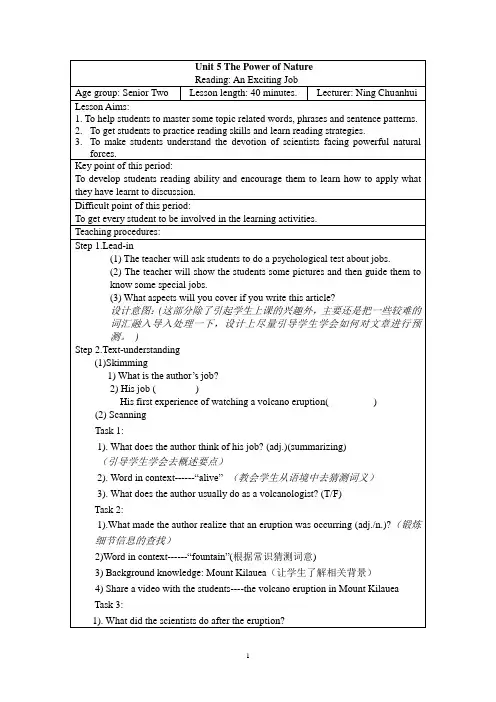
(put them in the right order)
2). Making inferences from the text.
What can we infer from these underlined words?
(“climbed down”, “boiling”, “slowly”)(教会学生根据文章词句做出合理的推理)
3). What’s the author’s attitude towards his job.(教会学生根据内容做出合理的推理)
4) Share a video with the students----how volcanologists conduct their researches.
(视频让学生直观感受火山学家工作的艰辛,为升华主题作铺垫)
设计意图:(通过各种不同的阅读活动设计,让学生自然的去感受和运用各种阅读技巧。
引领学生去了解火山学家的工作,慢慢深入去体会文中所想表达的思想。
)
Step 3. Extension
设计意图:(此活动的目的是帮助学生巩固所学知识,考虑到学生的实际情况,为降低难度,采访问题的提示就是学生导学案的设计)
Step4.Homework Assignment
(1)Read the text again and pay attention to language points in this passage.
(2)Try to write a short composition about an exciting job from your point of view.
设计意图:(作业目的是让学生对学过的知识进行复习巩固,提出进一步提升要求。
)。
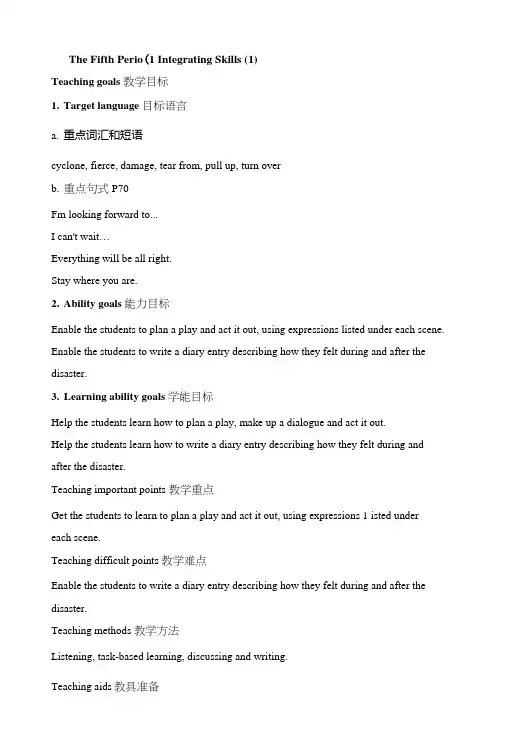
The Fifth Perio(1 Integrating Skills (1)Teaching goals 教学目标1.Target language 目标语言a.重点词汇和短语cyclone, fierce, damage, tear from, pull up, turn overb.重点句式P70Fm looking forward to...I can't wait…Everything will be all right.Stay where you are.2.Ability goals 能力目标Enable the students to plan a play and act it out, using expressions listed under each scene. Enable the students to write a diary entry describing how they felt during and after the disaster.3.Learning ability goals 学能目标Help the students learn how to plan a play, make up a dialogue and act it out.Help the students learn how to write a diary entry describing how they felt during and after the disaster.Teaching important points 教学重点Get the students to learn to plan a play and act it out, using expressions 1 isted under each scene.Teaching difficult points 教学难点Enable the students to write a diary entry describing how they felt during and after the disaster.Teaching methods 教学方法Listening, task-based learning, discussing and writing.Teaching aids教具准备A tape recorder and some pictures.Teaching procedures & ways 教学过程与方式Step I Talking (P69)T: Look at the picture on page 69, Talking. What happened to the house? Can you guess? SI: Maybe it was damaged in an earthquake.S2: Maybe a fierce cyclone happened in the area.T: You got it. The house was damaged by a cyclone. Have you experienced a cyclone before? Ss: No.T: How about typhoon, snowstorm or hailstorm? What are they like? You can choose one and describe it to your partners.Sample descriptions:HurricaneOne Friday, a hurricane struck the southeast of England. Between the midnight and 6:00 am the hurricane crossed the southeast corner of England with winds of up to 160 kph. It had been raining heavily for two days and the ground was very wet. Besides, it was autumn and the trees still had their leaves on. So the strong winds pushed over the trees easily. Fifteen million trees had been blown down by the strong wind. Power lines were brought down by fallen trees or branches. Electric and telephone services in some areas were cut down SnowstormOne night there was a heavy snowstorm, and in the morning people find their gardens were covered with thick snow. It's very difficult to walk in the street. Dustman had to clean the snow with forklift. Meanwhile, the early arrival of snow caused extensive damage to the trees. With the majority of trees yet to shed their leaves, the burden of the snow proved too heavy for many, and by Friday morning, the streets were littered with broken branches. HailstormIt was rare to see such a heavy hailstorm. A heavy downpour and table tennis-ball-sized hailstones attacked our town at 7:50 pm on Wednesd ay. On the street some big trees fell down in the hailstorm. Mr Wang stopped his car at the roadside to take shelter from the hailstorm, but the hailstorm almost broke the windows of his car. Farmers suffered a lot. Their corns and apple trees were destroyed completely.T: Excellent description. Look at the picture again. We know the house was destroyed by a fierce cyclone. It happened in Darwin, a city in the far north of Australia. Suppose we live in Darwin. What would you feel during the cyclone and after it was over?S3: I would be &lghtened by the strong wind and the huge noise it would make. I would stay in bed still and wait for the end of it. After it was over, I would be astonished by the big damages it had caused and feel helpless. How weak humans are before the natural forces!Step II Listening (P69)In this part, the students will listen to Christine talking about a cyclone she experienced. First get the students to read the seven sentences quickly and write 1-7 beside the events to show the order in which they happened. Then listen to check their answers. Listen to the tape for a second time to finish Exercise 2 on page 70.T: Now let's listen to Christine's description of a cyclone and see how she felt during and after the cyclone. The events have been listed but they are disordered. Read them quickly and write 1-7 beside the events to show the order in which they happened according to your own experience. Then we will listen to the tape and check your answers. Understand?Ss: YesThe students listen to check their answers. Then the teacher shows the correct answers.T: Where were the family members during the storm? Look at the floor plan on page 70. Write the names of the family members in the correct place on the floor plan. You can use a letter to stand for a family member when listening. Then rewrite their names after listening. LeTs begin. Are you ready?After listening, check their answers in class.Step in Writing (P74)T: Turn to page 74. We are going to practice writing a diary entry. Choose one of the natural disasters on the list or any other disaster you know about. Then imagine you were caught in this terrible natural disaster but you are safe now. Write a diary entry to explain how you felt during and after the disaster. First, make a timeline to show the order in which the events happen. You can follow the example. Now please choose a disaster and make atimeline.Ask the students to show their timelines before they write the dairy.A sample timeline: A hurricane4:00 pm Left home to go for a walk in the hills5: 00 pm Started to go back home, found the bridgehad been washed away by the floods, had tofind another way back5: 30 pm Started to wind6:00 pm Completely lost, had a rest to see where wewere6:30 pm Winds started to g. et strong, rained heavily7:00pm Found a cave, stayed in it till the rainstopped8:00 pm Returned to normal8:30 pm Went over the rocks and muddy road9: 30 pm Went home safelyT: OK! Now imagine you are safely back home after the disaste匸Write a diary entry about your experience and how you felt during it according to your timeline.A sample version:A HurricaneI am still terrified and a little excited. This afternoon my brother and I went to the hills to have a walk. It's too hot at home. We were walking and talking happily, when we feel cool wind blowing. "It's going to rain. Lets go home.” Jim said. "But we cannot get across the rive匚^ I said, pointing to the river. The bridge had been washed away by the floods. So we had to find another way back. We walked along the river, trying to find another way home. At that time, it started to wind. "Where are we? We are lost. I asked my brother anxiously. “Dorft worry. Be calm. Sit there to have a rest and I will climb up to the rock to see where we are. ” Jim comforted me. Then he climbed up to the rock. "I see the way.n he shouted happily. Unluckily, it began to rain and wind heavily. u We have to take shelterfrom the rain now.n Jim said, u After the rain stop we can leave here. There is a cave over there. I remember I have been there. ” We ran into the cave and collected some sticks to make a fire. It's for about an hour that we stayed in the cave. Everything returned to normal. We began to make our way home. The path was muddy and rocks were slippery. It took us a long time to go over the rocks and go home. My parents were about to look for us when we arrived home. They were anxious about us and believed we were lost. What exciting and adventurous experience!Step V HomeworkT: Please turn to page 75. In next period, we will make a classroom display about natural disasters. Read the instructions and do some preparations after class. Collect pictures and diagrams and look for information about:•what causes this kind of disaster;•actual events that happened in the past in China or the rest of the world;•how people helped the victims;•what is being done to prevent the disaster happening again or to lessen the damage.That's all for toda y. See you tomorrow.。
Unit5 The power of natureTeaching Content: Unit5 ,Module6 Teaching Class: Class 2, Senior 2Teaching aims:Knowledge:1.Get the students to understand the text fully.2.Get the students to master the power of volcano .Abilities:1. To improve the students’ reading abilities2. To train the students’ abilities of study by themselves .Emotion:1. Enable the student to understand the importance of naturel.2. Put the moral education in the process of studyTeaching important points:1. learn to to get the main idea2. Learn to get the detailed information. Teaching difficult points :How to help the students understand the text fully. Teaching method: cooperative learning, task-based teachingTeaching aids:A computer and a projectorⅤ. Teaching procedure:Step 1. GreetingStep2. Revision1. Review the words and phrases by listening to the tape and repeating.2.Review some natural disasters and get the hangs of volcanoStep3. Read the text carefully and finish reading tasksTask1: Read para1-2 carefully and get the answers1. Why does the writer say that he has the greatest job in the world?2. Why is a volcanologist’s job important?3. Where is Mount Kilauea?Task2: Read para3-4 carefully and answer the fowling questions4. Why is the lava that flows on Mount Kilauea more dangerous thanthe actual eruption?5. What caused the writer’s bedroom to become as bright as dayeven though it was night?6. Why did the scientists have to get close to the volcano after itbegan erupting?7. Why was it difficult for the writer to walk towards the edge of thecrater?Task3: Read para5 carefully and get the answerWhat does the writer find impressive about volcanoes even afterstudying them for many years?Task4:Get the main idea of the text.Step4.SummaryI have the ________ job in the world. I am never _____ with it. Although it is occasionally dangerous, I don’t mind because danger ______ me and makes me feel ____. I think my job is the most __________ because I can help _______ people from danger of volcanoes.I am a ___________ working for HVO. Our work has ______ many lives but unfortunately we can not save their _______. I have ___________ a volcano eruption in Hawaii. I was ____ asleep when my bed began _______ and I heard a _______ sound, like a _____ passing nearby. Then I found my bedroom was as ______ as day, and red lava was ___________ hundreds of meters into the air. The next day, three of us wanted to get close to the ______.We put on _________ suits, ________, big _______ and special ______, which made us look like __________. We slowly _____________ to the edge of the crater to collect some _____ for __________. After studying volcanoes for many years, I am just as ___________ about my job as before. Why? Because of their ________ and their _________ to cause great damage.Step6.Homework1.Finish the exercise on Page352.Try to retell the text。
《The power of nature》说课材料一、教材分析本节内容为人教版高中英语选修六第五单元第一课时,该单元的中心话题是火山、飓风、地震和洪水等自然灾害。
本单元以volcano 为主线,旨在通过单元教学使学生经过思考、学习,了解自然界的威力,认识到人类只有保护自然,才能有效地预防自然灾害并改造和利用自然。
本节课是一节阅读课。
阅读部分是一位火山学家自述。
作者介绍了他的工作性质,说明该工作的主要原因是能够帮助人们免遭火山袭击。
文章篇幅较长,专业词汇较多。
本节课的重点是引导学生分析文章结构,理解课文内容,培养学生良好的阅读习惯,提高学生的阅读能力。
通过阅读培养学生的自学能力,使其形成有效的学习策略。
通过本节课的学习,使学生树立“保护自然,预防自然灾害并改造自然”的意识。
二、学情分析授课班级为高二文科班。
经过高一一年的学习积累,学生已经有了一定的阅读基础。
但大多数学生还缺乏阅读技巧,英语口语表达能力还有待提高。
本课探讨自然灾害话题,学生在生活体验和地理知识方面,有一定的积累和初步的认知,但对于火山工作的性质了解得还不是特别清楚。
三、教法分析本节课采取多媒体辅助,以任务型教学为主的启发式教学,边演示边引导学生积极思维。
四、学法分析学会以小组讨论的自主合作探究。
五、教学目标分析本课的教学目标主要有两个方面:一是要求学生逐步掌握阅读理解中整体认知和细节理解,即“跳读法”。
所设计的阅读理解题型及难度和高考要求的水准基本保持一致,重点培养和提高学生的阅读能力。
二是在本课的基础上要求学生对于相关重点语法和词的运用具有变通的能力。
六、教学过程分析我设计的教学过程分六个环节。
环节一:导入。
上课开始,我设计了与本课主题有关联的问题,引导学生积极思考:Question: Brainstorm disasters caused by natural forces.Then lead to the topic.环节二:学习目标。
Unit5 The Power of Nature 说课稿Reading An Exciting JobPart 1 My understanding of this lessonThe analysis of the teaching material:This lesson is a reading passage. It plays a very important part in the English teaching of this unit. It tells us the wr iter’s exciting job as a volcanologist. From studying the passage, students can know the basic knowledge of volcano, and enjoy the occupation as a volcanologist. So here are my teaching goals:1. Ability goal:Enable the students to learn about the powerful natural force-volcano and the work as a volcanologist.2. Learning ability goal:Help the students learn how to analyze the way the writer describes his exciting job.3. Emotional goal: Make the Students love the nature and love their jobs.Learn how to express fear and anxietyTeaching important points: sentence structures1. I was about to go back to sleep when suddenly my bedroom became as bright as day.2. Having studied volcanoes now for more than twenty years, I am still amazed at their beauty as well as their potential to cause great damage.Teaching difficult points:1. Use your own words to retell the text.2. Discuss the natural disasters and their love to future jobs.Something about the S tudents:1. The Students have known something about vol cano but they don’t know the detailed information.2. They are lack of vocabulary.3. They don’t often use English to express themselves and communicate with others.4. Some Students are not active in the class because they are afraid of making mistakes.So I will help them to learn these knowledge and overcome the difficulties during my class. Part 2 My teaching theories, methods and aidsBefore dealing with this lesson, I’ll do my best to carry out the following theories: Make the Ss the real masters in class while the teacher himself acts as director;Combine the language structures with the language functions; Let the students receive some moral education while they are learning the English language.Teaching methods:Double activities teaching methodQuestion-and-answer activity teaching methodWatch-and-listen activityFree discussion methodPair work or individual work methodTeaching aids:1. a projector2. multimedia3. the blackboardPart 3. Teaching proceduresI have designed the following steps to train their ability of listening, speaking, reading and writing, especially reading ability.The entire steps are:Greetings, Revision, Lead-in and pre-reading, skimming, scanning, Intensive reading, Consolidation, Discussion, HomeworkHere are some main steps:L ead-inQ: In May, 2008, what happened to China? (Wenchuan earthquake)Do you know any other natural disasters? (typhoon, hurricane, storm, flood, drought)(powerpoint: pictures)What kind of things might a volcanologist do?Purpose: to let students know some basic information about volcano and the j-ob of vo lcanologist, make them eager to know more about the nature.SkimmingSkim the text and answer the following questions.1. What is the writer?2. When did he first see an eruption? How did it look like?3. What was he wearing when getting close to the crater? And what was the result? Purpose: to let students grasp the main idea of the passage. And find out some important information as quickly as possible.Scanning1. Read again and try to find out main ideas of each part.Part 1 (Para 1-2) The writer’s job and its importancePart2 (Para 3-4) The writer’s experience of watching the volcanic eruptionPart 3 (Para 5) The reasons for the writer’s enthusiasm about his job2. T or F questions.3. Explain some important sentences.(1)I was about to go back to sleep when suddenly my bedroom became as bright as day. (2)Having studied volcanoes now for more than twenty years, I am still amazed at their beauty as well as their potential to cause great damage.4. Consolidation: Retell (fill in the blanks according to the text).Purpose: to let students know the details of the passage. They will know the main idea of each part by doing ex.1, then through ex.2 they can correct some false information. And ex3 need my help, I can explain the difficult points and some sentence structures.Students can learn the passage as a whole from ex4.Discussion:1. Your experience of facing a natural disaster and your feelings about it.2. If you have a chance to choose your job, what will it be? Please tell us the reasons. Purpose: from this step, students can learn how to use the knowledge they have learned and show their love to their future jobs. What’s more, this can improve their speaking abilities. Part 4. Blackboard designleading the students to master the text easily. In this text, the design is not easy to write. I divide the blackboard into 3 parts. The left part is the main idea of each part, which can help students grasp the main idea. I write the important sentences on the blackboard in order to tell the students that this is of the importance in this class. The discussion is of the difficulty. I write down some students’ good ideas to let them learn because they may be useful in their writings.Ok, this is my design and it is the first time for me to this kind of job. I want to make the design logical, instructive and artistic. I would appreciate it if you can give me some advice after class. Thank you for your attention, thank you.。
Unit 5 the power of nature5个课时的教案(新课标版高二英语选修六教案教学设计)1. Teaching aims of this unitTalk about problems and benefits caused by volcanoes; carter lakes; cyclones and floods.Talk about the ways to express emotionsLearn to use the -ing formDescribe a natural disaster.2. Sentence patterns:Emotions:I’m looking forward to…You’ve done a good job.Don’t worry.How wonderful.3. The –ing form:Tell the difference between doing and having doneThe first period Warming upStep I Leading in1. Let the students list what they know about the nature disasters.2. Introduce some famous natural disasters.Step ⅡWarming –upAsk the students to talk about the following questions:① Have you ever seen a volcano in the flesh? If you have, share your experiences with your classmates and teachers?② Do you like exploring volcanoes? Are you afraid the dangers you may face?③ Do you know what a volcanologist do and how important his or her job is ?Step Ⅲ Pre- readingDiscuss in groups of four1. Do you like working outside as well as inside?2. Do you enjoy traveling to unusual places?3. Do you like adventure in your life?Step Ⅳ Learning the new words1. Read aloud the new words by themselves.2. Read aloud the new words after the tape.3. Read aloud the new words all together.Step Assignment1. Collect as much information about natural disasters as possible.2. Recite the first 20 new words.The second period ReadingStep ⅠRevision1. Greetings.2. Review the new words of this part.Step II Warming upDo you know any natural disasters ?1. Please work with your partners and make a list of natural disasters which you have known.2. What do you know about volcano?3. Do you know how a volcano erupts?Step III Reading1. Skimming1) What kind of things a volcanologist might do.2) What is the volcanologist wearing when getting close to the crater?2. Scanning1) Why is a volcanologist’s job important?2) Where is Mount Kilauea?3) Why is the lava that flows on Mount Kilauea more dangerous than the actual eruption?4) What caused the writer’s bedroom to become as bright as day even though it was night?5) Why did the scientists have to get close to the volcano after it began erupting?6) Why was it difficult for the writer to walk towards the edge of the crater?7) What does the writer find impressive about volcanoes even after studying them for 20 years?3. Intensive readingFind out the main idea of the passage:Part 1(Pa 1-2) What is the writer’s job a nd the importance of his job?Part 2(Pa 3-4) The writer’s experience of watching the volcano eruptionPart 3(Pa 5) The reasons why the writer is enthusiastic about his job?4. Creative group discussion:1)Having learnt a little more about the work of a volcanologist, do you think it is an occupation you would enjoy? Discuss your reasons with others in your class.2) If you could meet the writer of the passage, what kind of questions would you ask? Discuss with others in your class.Step Ⅲ Assignment1. Page 35 ~~36 Learning about language2. Page 70 Ex 1The third period Learning about languageStep Ⅰ Greeting and Revision( Ask some students to retell the text we learned .)StepⅡ. Practicing the useful words and expressions1. Read the new words.2. Check the answers to Learning about language and Page 70 Ex 1. Explain in details if the students have any difficulties.3. Finish all the exercises in Section one of 《中华一题》。
英语:Unit5《The power of nature》教案(5)(新人教版选修6)The first period Warming up and pre-readingWarming upIn order to talk about what volcanoes are and how they are formed, students need to learnSome new words: lava erupt/eruption crater active/dormant/extinct volcanoesShow some pictures of disastersAsk student to name disasters as much as they know.Sample answer: cyclone typhoon Hurricane tornado snowstorm landslideV olcano tsunami earthquake flood hailstorm sandstormask them What they feel when they see the power of nature showing in the pictures:Have you ever experienced one ?Share you experience and feelings ? (were you frightened and how frightened were you?)Some expressions tips: scared to death frightened worriedunforgettable unbelievableHave you ever seen a volcano ?Ask Ss to complete exercise 1 in groups. Then check their answers orally as a whole class.Ask students to help you make a list of words connected with volcanoesDiscuss with students where in the world active and extinct volcanoes occur.2. pre-reading1) Can you tell me who will climb into a live volcano in order to take the temperatureof the boiling rock inside ?volcanologists——do they take up a crazy job?get the students to answer the six questions in pre-reading to find out whether they willenjoy working as a volcanologist.Students could do this activity as a survey by asking others in their class these questionsOr they could do it individually.after they have completed the task, survey the class to find out how many might enjoythe work of a volcanologist.their guesses were.The second period Reading and comprehending1.First readingSkinning & skimming1)Ask students to read through the passage quickly to get a main idea ofthe whole passage. Give them a limited time to read the whole passagein order to encourage them to practice reading for general ideas and todiscourage them from reading word by wordmain idea: This passage is a first-person account of a volcanologist’s experiences. The volcanologist described his exciting job and wrote down his first sight of an eruption.What does a volcanologist do ?( answer in the text )Then let students do the multiple-choices (见课件)2)Set Exercise 1 in “comprehending”either as a group or whole-class activity. Explain to students that the purpose of questions like these is to help them develop skills of evaluating a text.2.Second reading (intensive reading)Before reading, glance through Exercise 2 on Page35.Choose some to ask them and check their answers:1). Why is a volcanologist’s job important ?V olcanologists study volcanoes so that they can warn people when the volcano is going to erupt and so save many lives.2). Why is the lava that flows on Mount Kilauea more dangerous than the actualeruption ?The lava flows down the mountain and can cover up or burn villages in its path. the rocks that erupt from the volcano usually don’t damage anything because no one lives the crater.3). Why was it difficult for the writer to walk towards the edge of the crater ?The author was wearing special protective clothing that made it difficultto walk4). What does the writer find impressive about volcanoes even after studying them for 20 years ? The author is impressed by the beauty of the eruption and also by its potential to cause greatdestruction.3.Third reading (Read again to find more details)1).what made the author realize that an eruption occurred ?answer: my bed began shakinga strange soundmy bedroom became as bright as dayan abosolutely fantastic sightred hot lava was fountaining hundreds of metres into the air2).what did the scientists do after the eruption ?answer: put on white protective suits, helmets, big bootsdropped as closed as possible to the craterslowly make our way to the edge of the craterlooked down into the red boiling centerHomeworkSpend some time researching one disaster. You can use books, magazines, newspapers or the Internet. Collect pictures and diagram and look for information about:•what causes this kind of disaster•actrual events that happened in the past in china and/or the rest of the world•how people helped the victims•what is being done to prevent the disarster happening again or to lessen the damage名师精编优秀教案。
Unit5 The Power of Nature 说课稿Reading An Exciting JobPart 1 My understanding of this lessonThe analysis of the teaching material:This lesson is a reading passage. It plays a very important part in the English teaching of this unit. It tells us the wr iter’s exciting job as a volcanologist. From studying the passage, students can know the basic knowledge of volcano, and enjoy the occupation as a volcanologist. So here are my teaching goals:1. Ability goal:Enable the students to learn about the powerful natural force-volcano and the work as a volcanologist.2. Learning ability goal:Help the students learn how to analyze the way the writer describes his exciting job.3. Emotional goal: Make the Students love the nature and love their jobs.Learn how to express fear and anxietyTeaching important points: sentence structures1. I was about to go back to sleep when suddenly my bedroom became as bright as day.2. Having studied volcanoes now for more than twenty years, I am still amazed at their beauty as well as their potential to cause great damage.Teaching difficult points:1. Use your own words to retell the text.2. Discuss the natural disasters and their love to future jobs.Something about the S tudents:1. The Students have known something about vol cano but they don’t know the detailed information.2. They are lack of vocabulary.3. They don’t often use English to express themselves and communicate with others.4. Some Students are not active in the class because they are afraid of making mistakes.So I will help them to learn these knowledge and overcome the difficulties during my class. Part 2 My teaching theories, methods and aidsBefore dealing with this lesson, I’ll do my best to carry out the following theories: Make the Ss the real masters in class while the teacher himself acts as director;Combine the language structures with the language functions; Let the students receive some moral education while they are learning the English language.Teaching methods:Double activities teaching methodQuestion-and-answer activity teaching methodWatch-and-listen activityFree discussion methodPair work or individual work methodTeaching aids:1. a projector2. multimedia3. the blackboardPart 3. Teaching proceduresI have designed the following steps to train their ability of listening, speaking, reading and writing, especially reading ability.The entire steps are:Greetings, Revision, Lead-in and pre-reading, skimming, scanning, Intensive reading, Consolidation, Discussion, HomeworkHere are some main steps:L ead-inQ: In May, 2008, what happened to China? (Wenchuan earthquake)Do you know any other natural disasters? (typhoon, hurricane, storm, flood, drought)(powerpoint: pictures)What kind of things might a volcanologist do?Purpose: to let students know some basic information about volcano and the j-ob of vo lcanologist, make them eager to know more about the nature.SkimmingSkim the text and answer the following questions.1. What is the writer?2. When did he first see an eruption? How did it look like?3. What was he wearing when getting close to the crater? And what was the result? Purpose: to let students grasp the main idea of the passage. And find out some important information as quickly as possible.Scanning1. Read again and try to find out main ideas of each part.Part 1 (Para 1-2) The writer’s job and its importancePart2 (Para 3-4) The writer’s experience of watching the volcanic eruptionPart 3 (Para 5) The reasons for the writer’s enthusiasm about his job2. T or F questions.3. Explain some important sentences.(1)I was about to go back to sleep when suddenly my bedroom became as bright as day. (2)Having studied volcanoes now for more than twenty years, I am still amazed at their beauty as well as their potential to cause great damage.4. Consolidation: Retell (fill in the blanks according to the text).Purpose: to let students know the details of the passage. They will know the main idea of each part by doing ex.1, then through ex.2 they can correct some false information. And ex3 need my help, I can explain the difficult points and some sentence structures.Students can learn the passage as a whole from ex4.Discussion:1. Your experience of facing a natural disaster and your feelings about it.2. If you have a chance to choose your job, what will it be? Please tell us the reasons. Purpose: from this step, students can learn how to use the knowledge they have learned and show their love to their future jobs. What’s more, this can improve their speaking abilities. Part 4. Blackboard designleading the students to master the text easily. In this text, the design is not easy to write. I divide the blackboard into 3 parts. The left part is the main idea of each part, which can help students grasp the main idea. I write the important sentences on the blackboard in order to tell the students that this is of the importance in this class. The discussion is of the difficulty. I write down some students’ good ideas to let them learn because they may be useful in their writings.Ok, this is my design and it is the first time for me to this kind of job. I want to make the design logical, instructive and artistic. I would appreciate it if you can give me some advice after class. Thank you for your attention, thank you.。